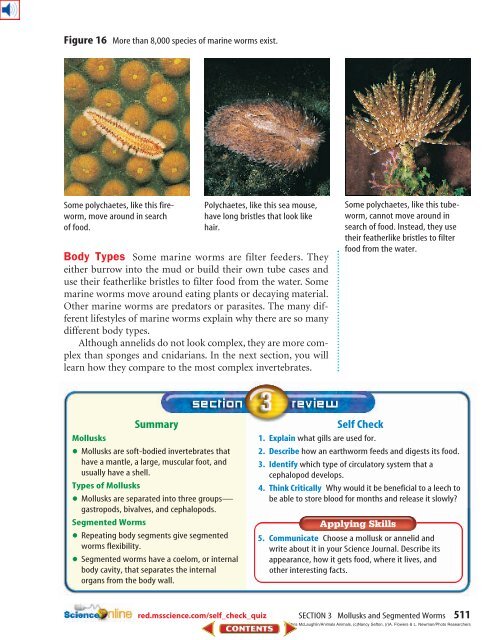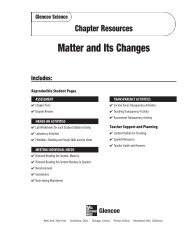Chapter 17: Invertebrate Animals
Chapter 17: Invertebrate Animals
Chapter 17: Invertebrate Animals
Create successful ePaper yourself
Turn your PDF publications into a flip-book with our unique Google optimized e-Paper software.
Figure 16 More than 8,000 species of marine worms exist.<br />
Some polychaetes, like this fireworm,<br />
move around in search<br />
of food.<br />
Polychaetes, like this sea mouse,<br />
have long bristles that look like<br />
hair.<br />
Body Types Some marine worms are filter feeders. They<br />
either burrow into the mud or build their own tube cases and<br />
use their featherlike bristles to filter food from the water. Some<br />
marine worms move around eating plants or decaying material.<br />
Other marine worms are predators or parasites. The many different<br />
lifestyles of marine worms explain why there are so many<br />
different body types.<br />
Although annelids do not look complex, they are more complex<br />
than sponges and cnidarians. In the next section, you will<br />
learn how they compare to the most complex invertebrates.<br />
Some polychaetes, like this tubeworm,<br />
cannot move around in<br />
search of food. Instead, they use<br />
their featherlike bristles to filter<br />
food from the water.<br />
Summary<br />
Mollusks<br />
•<br />
Mollusks are soft-bodied invertebrates that<br />
have a mantle, a large, muscular foot, and<br />
usually have a shell.<br />
•<br />
Types of Mollusks<br />
Mollusks are separated into three groups—<br />
gastropods, bivalves, and cephalopods.<br />
•<br />
Segmented Worms<br />
Repeating body segments give segmented<br />
•<br />
worms flexibility.<br />
Segmented worms have a coelom, or internal<br />
body cavity, that separates the internal<br />
organs from the body wall.<br />
Self Check<br />
1. Explain what gills are used for.<br />
2. Describe how an earthworm feeds and digests its food.<br />
3. Identify which type of circulatory system that a<br />
cephalopod develops.<br />
4. Think Critically Why would it be beneficial to a leech to<br />
be able to store blood for months and release it slowly<br />
5. Communicate Choose a mollusk or annelid and<br />
write about it in your Science Journal. Describe its<br />
appearance, how it gets food, where it lives, and<br />
other interesting facts.<br />
red.msscience.com/self_check_quiz<br />
SECTION 3 Mollusks and Segmented Worms 511<br />
(l)Chris McLaughlin/<strong>Animals</strong> <strong>Animals</strong>, (c)Nancy Sefton, (r)A. Flowers & L. Newman/Photo Researchers














